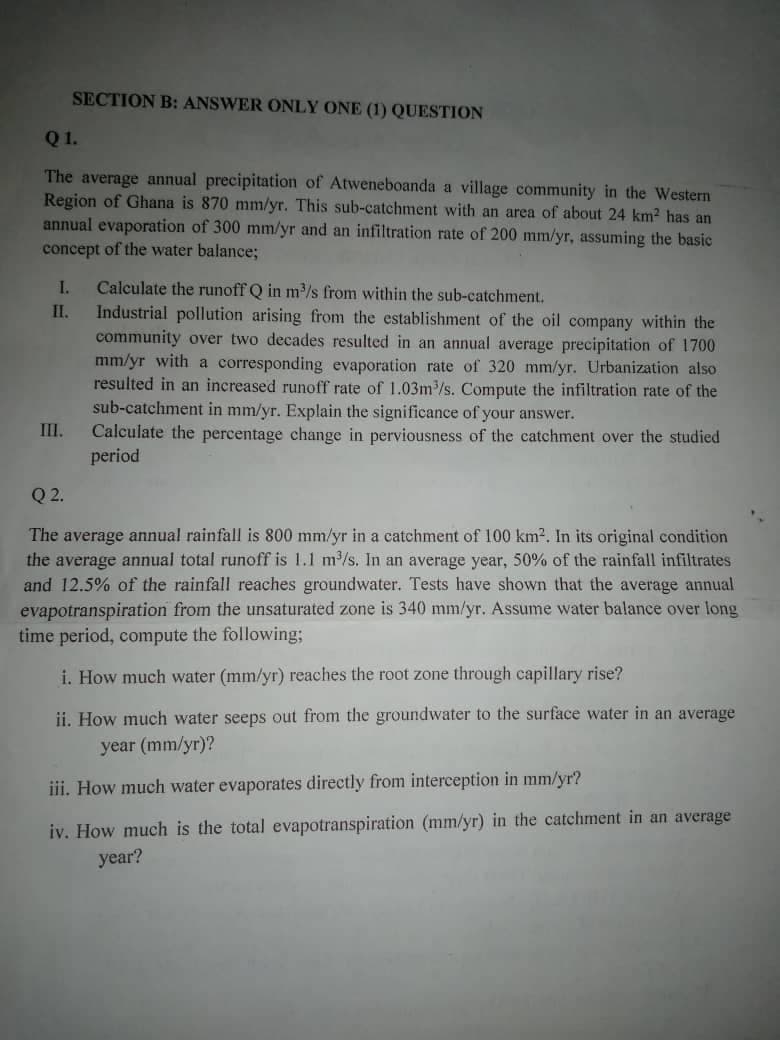SECTION B: ANSWER ONLY ONE (1) QUESTION Q1. The average annual precipitation of Atweneboanda a village community in the Western Region of Ghana is 870 mm/yr. This sub-catchment with an area of about 24 km2 has an annual evaporation of 300 mm/yr and an infiltration rate of 200 mm/yr, assuming the basic concept of the water balance; Calculate the runoff Q in m/s from within the sub-catchment. Industrial pollution arising from the establishment of the oil company within the community over two decades resulted in an annual average precipitation of 1700 mm/yr with a corresponding evaporation rate of 320 mm/yr. Urbanization also resulted in an increased runoff rate of 1.03m/s. Compute the infiltration rate of the sub-catchment in mm/yr. Explain the significance of your answer. I. II.
SECTION B: ANSWER ONLY ONE (1) QUESTION Q1. The average annual precipitation of Atweneboanda a village community in the Western Region of Ghana is 870 mm/yr. This sub-catchment with an area of about 24 km2 has an annual evaporation of 300 mm/yr and an infiltration rate of 200 mm/yr, assuming the basic concept of the water balance; Calculate the runoff Q in m/s from within the sub-catchment. Industrial pollution arising from the establishment of the oil company within the community over two decades resulted in an annual average precipitation of 1700 mm/yr with a corresponding evaporation rate of 320 mm/yr. Urbanization also resulted in an increased runoff rate of 1.03m/s. Compute the infiltration rate of the sub-catchment in mm/yr. Explain the significance of your answer. I. II.
Chapter2: Loads On Structures
Section: Chapter Questions
Problem 1P
Related questions
Question

Transcribed Image Text:SECTION B: ANSWER ONLY ONE (1) QUESTION
Q1.
The average annual precipitation of Atweneboanda a village community in the Western
Region of Ghana is 870 mm/yr. This sub-catchment with an area of about 24 km2 has an
annual evaporation of 300 mm/yr and an infiltration rate of 200 mm/yr, assuming the basic
concept of the water balance;
Calculate the runoff Q in m/s from within the sub-catchment.
Industrial pollution arising from the establishment of the oil company within the
community over two decades resulted in an annual average precipitation of 1700
mm/yr with a corresponding evaporation rate of 320 mm/yr. Urbanization also
resulted in an increased runoff rate of 1.03m/s. Compute the infiltration rate of the
sub-catchment in mm/yr. Explain the significance of your answer.
Calculate the percentage change in perviousness of the catchment over the studied
period
I.
II.
III.
Q 2.
The average annual rainfall is 800 mm/yr in a catchment of l100 km2. In its original condition
the average annual total runoff is 1.1 m/s. In an average year, 50% of the rainfall infiltrates
and 12.5% of the rainfall reaches groundwater. Tests have shown that the average annual
evapotranspiration from the unsaturated zone is 340 mm/yr. Assume water balance over long
time period, compute the following3;
i. How much water (mm/yr) reaches the root zone through capillary rise?
ii. How much water seeps out from the groundwater to the surface water in an average
year (mm/yr)?
iii. How much water evaporates directly from interception in mm/yr?
iv. How much is the total evapotranspiration (mm/yr) in the catchment in an average
year?
Expert Solution
This question has been solved!
Explore an expertly crafted, step-by-step solution for a thorough understanding of key concepts.
This is a popular solution!
Trending now
This is a popular solution!
Step by step
Solved in 2 steps

Knowledge Booster
Learn more about
Need a deep-dive on the concept behind this application? Look no further. Learn more about this topic, civil-engineering and related others by exploring similar questions and additional content below.Recommended textbooks for you


Structural Analysis (10th Edition)
Civil Engineering
ISBN:
9780134610672
Author:
Russell C. Hibbeler
Publisher:
PEARSON

Principles of Foundation Engineering (MindTap Cou…
Civil Engineering
ISBN:
9781337705028
Author:
Braja M. Das, Nagaratnam Sivakugan
Publisher:
Cengage Learning


Structural Analysis (10th Edition)
Civil Engineering
ISBN:
9780134610672
Author:
Russell C. Hibbeler
Publisher:
PEARSON

Principles of Foundation Engineering (MindTap Cou…
Civil Engineering
ISBN:
9781337705028
Author:
Braja M. Das, Nagaratnam Sivakugan
Publisher:
Cengage Learning

Fundamentals of Structural Analysis
Civil Engineering
ISBN:
9780073398006
Author:
Kenneth M. Leet Emeritus, Chia-Ming Uang, Joel Lanning
Publisher:
McGraw-Hill Education


Traffic and Highway Engineering
Civil Engineering
ISBN:
9781305156241
Author:
Garber, Nicholas J.
Publisher:
Cengage Learning